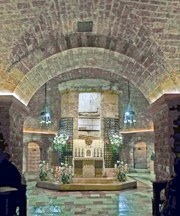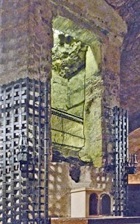As explained in more detail below, the crypt was carved from the rock under the lower church in 1822, in order to allow pilgrims access to the burial place of St Francis, which had been inaccessible for some six hundred years. The sarcophagus in which St Francis was originally buried, which still contains his relics, is now exposed above its altar. It is viewed through an opening in the burial chamber that was cut into the rock some 4 meters below the high altar of the lower church in 1230, when the relics were translated to San Francesco. (See the page on San Francesco in 1228-53 for the historical context.)
Translation (1230)
The relics of St Francis were translated from San Giorgio to San Francesco in 1230. Pope Gregory IX could not attend the ceremony of translation in person because he was involved in peace negotiations with the Emperor Frederick II. However, three cardinals represented him, and many other dignitaries must have been present at the ceremony, which was timed to coincide with the meeting of the Franciscan General Chapter at Assisi. The early biographies of St Francis make no mention of anything untoward during the ceremony, but Gregory IX issued a furious bull (Speravimus hactenus) on 16th June in which he threatened the friars of San Francesco and the civic authorities with dire punishment for having disrupted the proceedings. It seems that the body had been translated three days before the planned event.
Fortunately, Gregory IX was soon placated, and the threatened punishments did not materialise, probably because the offenders were able to justify their actions. The most likely explanation is that they had received some kind of warning that the relics would otherwise have been in danger, possibly from a Perugian assault.
Hidden Tomb
It is unlikely that the tomb of St Francis was ever accessible to pilgrims: the altar above probably served as a surrogate burial locus, although the grate in the steps of the high altar of the lower church (which still survives) probably directed their attention towards the actual burial spot. Certainly by the end of the 14th century, detailed knowledge of the precise location of the sarcophagus had been lost.
A 15th century account has Pope Sixtus IV venerating the relics (on which the stigmata could still be seen ) in ca. 1476, before ordering that the tomb should be sealed, but this can probably be discounted.
Rediscovery of the Sarcophagus
After unsuccessful attempts to locate the sarcophagus in 1755 and 1802, Pope Pius VII sanctioned a third campaign in 1806, but this campaign was halted when the French invaded the Papal States in 1808. Some friars managed to remain unofficially in the Sacro Convento during the suppression, and an unfounded rumour had it that they had found the tomb of St Francis and his uncorrupted body. The rumours intensified after the friars were able to return in 1814, and such was the pressure that Pius VII sanctioned the resumption of the campaign to find the tomb in 1818. One of the earlier excavation tunnels from the lower church was re-opened, and after some 52 nights of work of digging away the solid rock, the sarcophagus and was found.
This travertine sarcophagus, which dates to the Roman period, seems to have served as a drinking trough for animals before it was used for the burial of St Francis. It had lost its original lid, but was covered by an iron grating. It lay on a second grating that was attached to the first by iron bars that in effect formed a secure cage. It rested on a pavement of ten slabs laid on the solid rock some 4 meters below the floor of the upper church, directly under the high altar.
The sides of the excavated chamber had been faced before the encaged sarcophagus had been lowered into it. A massive travertine slab had then been used to cover the upper grating. This had been secured by more iron bars and two more slabs had then been laid on top of it. What seems to have been a small empty chamber above the protected sarcophagus had been filled with cement at a later date. Even before this was done, there would have been no access to this chamber (or to the sarcophagus below it) once the high altar had been installed above it. (A similar arrangement seems to have been used at Santa Chiara, where the relics of St Clare were rediscovered under the high altar in 1850).
Pius VII decreed that the "venerable body [of St Francis] should not be transported elsewhere from the underground place in which it has lain for nearly six centuries, ... [that] the whole tomb should be embellished, ... and that a more convenient, entrance should be opened to it". This led to the construction of the present crypt, which was carved from the rock in 1822 in accordance with a design by Pasquale Belli. The crypt was remodelled in neo-Romanesque style by Ugo Tarchi in 1925-32.
In 1934:
-
✴the remains of four early followers of St Francis, Brothers Leo, Masseo, Rufino and Angelo, were moved from the left transept of the lower church to niches in the curved back wall of the crypt; and
-
✴the casket containing the remains of the Roman noble woman, Jacopa de Settesoli, whom St Francis dubbed “Frate Jacopa”, was moved from the left side of the nave of the lower church to the junction of the two flights of steps that lead down to the crypt.
Relics of St Francis
When the sarcophagus was opened in 1818, the body of St Francis was found to be essentially in tact, with a piece of rough stone still serving as a pillow. There were a few coins in the sarcophagus dating to the period 1181-1208, as well as a number of tiny beads from a necklace and an antique silver ring with an oval cornelian incised with a figure of Minerva. The stone pillow and the coins are now in the Cappella delle Reliquie, but the ring has been lost.
Pius VII commissioned Bishop Francesco Maria Giampè of Assisi and the bishops of Nocera, Spoleto, Perugia and Foligno and a number of experts to authenticate the relics. He then confirmed their authenticity in the bull "Assisiensem Basilicam" (1820). The bones were then wrapped in silk and placed in a reliquary that was returned to the sarcophagus. This was fitted with a wooden lid and returned to the original burial chamber in 1824, where it was visible to pilgrims for the first time in its history.
Pope Paul VI sanctioned the re-opening of the sarcophagus and the reliquary in 1978 to allow the state of preservation of the relics to be investigated. Some action was taken to preserve them, and they were then sealed into a plexiglas urn with a nitrogen atmosphere. This was returned to the 19th century reliquary, which was in turn placed in the original sarcophagus complete with a new travertine lid. The original upper and lower gratings were fixed in place and the sarcophagus was returned to the burial chamber.
Read more:
R. Brooke, “Image of St Francis: Responses to Sainthood in the 13th Century”, (2006) Cambridge (Chapter 10)
D. Cooper, "In Loco Tutissimo et Firmissimo: the Tomb of St Francis in History, Legend and Art",
in W. Cook (Ed.), "The Art of the Franciscan Order in Italy", (2005) Leiden, pp 1-38
A copy of the encyclical letter issued by the Minister General after the investigation of the relics in 1978 is given in the website of the EWTN Global Catholic Network.
Return to the page on the Lower Church.
Return to the main page on San Francesco.
Return to Walk III.
Return to the home page on Assisi.





